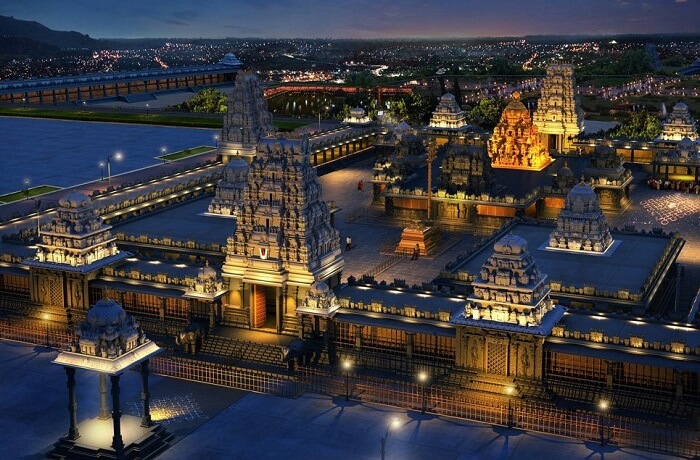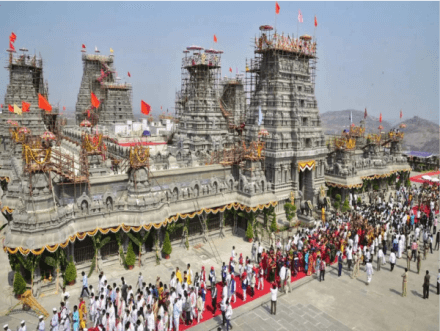Yadagirigutta TempleYadagirigutta is the most exceptional, lovely, and attractive hill with a pleasant climate throughout the year, and the temple is situated around 60 kilometres from Hyderabad, the capital of Telangana. Due to its proximity to the capital city, the flow of worshippers visiting the temple is extremely large. A minimum of 5000-8000 pilgrims often visit this temple every day to make promises and practise Saswata pujas, Saswata kalyanam, LakshaTulasi Pujas, Abhisekam, and many more. Overcrowding of visitors and worshippers is expected on weekends and other public holidays. 
It is a well-known Hindu temple dedicated to Narasimha Swamy, an avatar of Lord Vishnu, is Sri Lakshminarasimha Swamy Temple, or Yadagirigutta. Yadagirigutta is located on a hill in the Nalgonda region of Telangana, 6 kilometres from Riagir Railway Station, 13 kilometres from Bhongir Town, and 60 kilometres from Hyderabad. HistoryThe famous philosopher Rishyasrunga's son, Yadarishi, resided in Tretayugam and performed meditation in a cave with the grace of Anjaneya (Hanuman) upon the hill between Bhongir (Bhuvanagiri) and Raigiri (in the Nalgonda district of Telangana now). Sri JwalaNarasimha, an avatar of Lord Vishnu, came before him in five distinct forms: Sri JwalaNarasimha, Sri Yogananda, Sri Gandabherunda, Sri Ugra, and Sri Lakshminarasimha, because he was impressed with his true devotion. All five of these avatars (roopas) are currently idolised there. They subsequently appeared as intricately designed figures that were known as Pancha Narasimha Kshetram, the element of worship. Anand Sai is the genius behind the temple's structure. He has been working on the Yadagirigutta temple project for a period of six years as its chief architect. A historical monument at the Kolanupaka Jagaddevuni Narayana Swamy Temple records that King Tribhuvana Malludu established a monument on the Ekashila Hillock near Bhongir in memory of his victory in Telangana in the year 1148, after Christ. He made numerous trips to Lord Lakshmi Narasimha Swami during the same period. The Vijayanagara Samrajya Samrat Sri Krishnadevarayalu stated in his autobiography published in the 15th century that before going to battle he went to the temple and worshipped the Lord for success. Furthermore, he was blessed by Lord Narasimha Swamy with a son. StructureAnand Sai was the main architect, and P Madhusudhan (the chief designer) was selected for his familiarity with traditional designs based on silpa and agama ideas. The temple is made completely of stone. Sundararajan Srinivasan, the temple's main sthapathi, contributed to the stone carvings at Yadadri. There are three different kinds of stone featured in the temple: Napunsaka Sila is used for the floors and walls, while Sthri Sila is used for goddess statues. Krishna Sila, also called Purusha Sila, serves as the supreme lord in the central dome. Based on Telangana's Kakatiya Dynasty architecture and sculpture, black granite stone is also employed. According to knowledgeable Shilipis(sculpture experts), the black granite stone possesses minute holes that turn powerful and hard when dairy, yoghurt, fat, and other liquids enter them. The temple's design was inspired by Agama Shashtra. The temple was originally constructed on 2 acres of land. The foundation for the temple has now become 14 acres after rebuilding every building on the temple hill. To reach the main temple, you have to climb a good number of steps, around 75. The temple administration keeps pushing you through the line without enabling you to view the Lord properly. The temple, its surroundings, and the foothills are all undergoing extensive renovations. BeliefsAccording to widespread belief, Lord Narasimha, also called "Vaidya Narasimha" by his worshippers at this temple, has adopted the roles of a "doctor" and a "do-gooder" for individuals who are affected by evil planets, witches, and black magic. There are numerous accounts of the Lord appearing to worshippers in their dreams, providing medicine, treating patients, and showering their healthy bodies. Several believers describe dramatic dreams that involve the Lord appearing to cure them of long-term or fatal ailments, as well as psychological or emotional troubles. Many worshipers usually perform a mandala (40-day) pradakshina in an attempt to get relief from a prolonged sickness or medical problem. The Lord has usually given mantropadesham to certain believers in their dreams. The Hours of the Yadagirigutta TempleEvery day, the temple is open from 4 a.m. until 9:30 p.m. The afternoon break lasts from 3 to 4 p.m. October to March is the perfect season to visit Yadagiri Gutta. During the weekends, holidays, and festivals, the area experiences a major bustle. There are several private resorts and several religious visitor homes that offer lodges. 
New Yadadri TempleOn the location of the ancient temple, a new Yadadri temple is being constructed. Chinna Jeeyar Swamy additionally renames the temple Yadadri. Moreover, he supervises and directs the building of the new temple. By the end of 2019, the full temple construction project is expected to be finished. By the end of 2019, the new Yadagirigutta Temple model is predicted to be completed. Inside the Yadagirigutta TempleThe Yadagirigutta Temple is located inside a cave that is 30 feet in length and 12 feet in height. The Garbhagriha, or sanctum sanctorum, is situated next to a large rock inside the cave. Furthermore, the temple's point of entry arch symbolizes Mahabhuta (the five elements). In the major cave of the temple, Lord Narasimha is also displayed in all five of his stone-embossed avatars. The form of Jwala Narasimha is that of a snake. Similarly, Yogananda Narasimha makes an appearance while seated in a yoga pose for meditation. A Hanuman temple is located to the right of the temple's main entrance. Just below Hanuman, you can notice a considerable horizontal gap inside the rock. The festivals celebrated at Yadadri TempleBrahmotsavam pooja is being performed by priests in Yadagirigutta
Donations and RenovationsThe reconstruction of the temple was initiated by Telangana's Chief Minister, K. Chandrashekhar Rao, who also gave his consent to the final design. Funding of 1800 crores is being spent on massive temple restoration. The Yadadri Temple Development Authority (YTDA) began the project in 2016, and it will be finished by March 2022. To decorate the gopurams and walls of the temple, the temple acquired 1,753 tonnes of silver and 39 kilogrammes of gold. Various stone components are brought together using a method that has existed for centuries, namely lime mortar. With 300 crores of rupees, the YTDA bought about 1900 acres. Furthermore, residences are built close to Vishnu Gundam (the bathroom). During the tenure of Mir Osman Ali Khan, the seventh Nizam of Hyderabad, he donated Rs. 82,825 to this temple.
Next TopicChottanikkara Temple
|
 For Videos Join Our Youtube Channel: Join Now
For Videos Join Our Youtube Channel: Join Now
Feedback
- Send your Feedback to [email protected]
Help Others, Please Share










